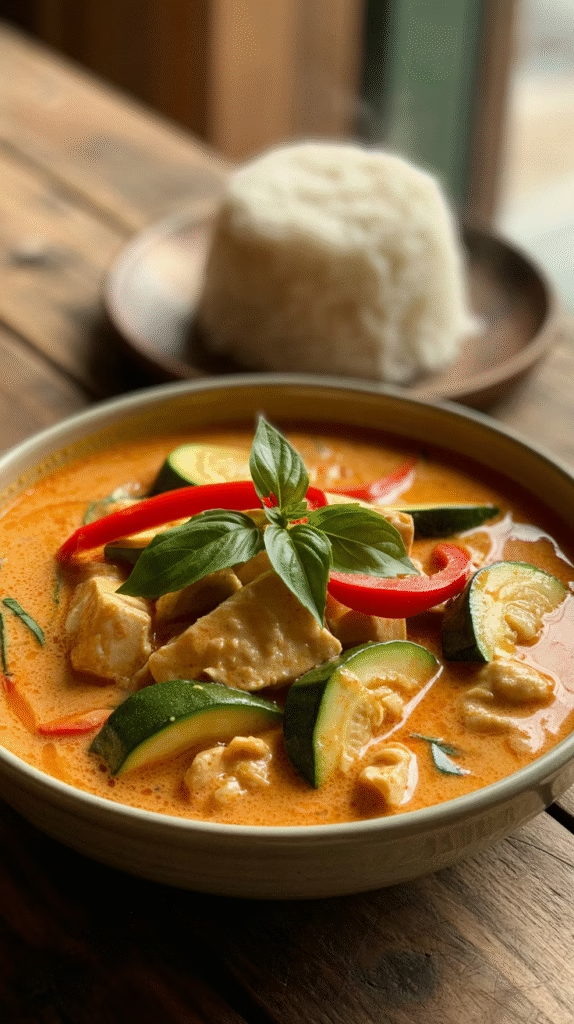Some dishes look fancy but are way easier than you’d guess. Thai red curry is one of those. The flavors jump out—spicy, creamy, a little sweet―but you don’t need special skills to get it right at home. If you like quick meals, bold tastes, and not much mess, this is for you.
There are a lot of Thai curries. Red curry stands out because of its color, which comes from dried red chilies in the curry paste. It works with chicken, tofu, shrimp, or straight-up veggies. Plus, most of the ingredients are easy to find in big grocery stores now.
So here’s my step-by-step for Thai red curry, just like I’d explain it to a friend. No fluff. Just what you need to get a great pot of curry on the table.

Why I Keep Coming Back to Thai Red Curry
This recipe saved me on nights when takeout sounded good, but my fridge had stuff to use up. Sometimes we make it family-style with lots of veggies; other times, I keep it simple with just chicken or tofu. It’s friendly for picky eaters too—adjust the heat, change the veggies, or use whatever protein you have. The leftovers are even better the next day.
The sauce is the real draw. Coconut milk gives it a thick base. Red curry paste brings in spice, garlic, a little ginger, and lemongrass—all in one spoonful. It’s not complicated, but it doesn’t taste basic.
Key Ingredients (And How To Swap If You Need)
I like to highlight what goes in and offer some options for people who might need to swap. Here’s what’s in my usual version:
- Red curry paste: The key flavor. Thai Kitchen and Mae Ploy are solid brands. If you want less heat, start with one tablespoon; add more if you like spice.
- Coconut milk: Full-fat coconut milk works best and gives the sauce that silky texture. Don’t use “lite.” If you like curry thinner, you can add a splash of water, but don’t skip the main stuff.
- Chicken breast: Boneless, skinless, cut into pieces. Tofu works just as well for a non-meat version. Shrimp cooks even faster and works great here, too.
- Bell pepper and zucchini: These veggies hold their shape and add color. You can use green beans, eggplant, mushrooms, or carrots—whatever you have.
- Onion: A small yellow or white onion for base flavor.
- Fish sauce: Adds saltiness and depth. Use soy sauce if you need it vegan.
- Sugar: Just a little—balances the salt and spice.
- Basil leaves: Fresh basil right at the end lifts the whole thing. Thai basil is best, but regular works if that’s what you have.
- Oil: Just a tablespoon for cooking.
- Steamed rice: White or jasmine rice for serving.
These basics will get you to a classic Thai curry. Don’t have everything? That’s fine. The goal is a rich, warm curry with some veggies and protein.
Equipment Checklist
- Big skillet or wok (nonstick or stainless is fine)
- Cutting board and sharp knife
- Cooking spoon or spatula
- Measuring spoons
- Saucepan for rice
You don’t need fancy gear for this recipe. That’s part of why I like it.

Step-By-Step Instructions
Here’s how I make it, one move at a time. I try to keep each step clear and direct—no jumbling or mixing steps. This is how it actually plays out in my kitchen.
- Chop everything first.
Cut chicken (or tofu) in small, even pieces. Slice onion, bell pepper, and zucchini. That way, you won’t be rushing between the stove and the cutting board. - Start the rice.
Get your rice going before curry starts if you want everything to finish together. Use 1 cup rice to 2 cups water for three to four servings. - Cook the onion.
Heat a tablespoon of oil in your big skillet over medium heat. Add the sliced onion. Cook for 2 minutes, just until it loosens up and gets a bit soft. - Add curry paste.
Scoop in the red curry paste. Stir and cook for one minute. It’ll get fragrant. This quick cooking wakes up the flavors. - Mix in half the coconut milk.
Pour about half the can of coconut milk into the pan. Stir until the paste is blended in and the mix goes from deep red to a smooth sauce. - Add protein.
Drop in your chicken or tofu pieces. Stir so everything gets coated. Cook for 3–4 minutes, stirring here and there. The chicken will go from pink to mostly white but won’t be cooked through yet. - Add veggies and the rest of the coconut milk.
Put in your bell pepper and zucchini. Pour in what’s left of the coconut milk. Stir well. Let the pan come to a gentle simmer (small bubbles at the edges). - Season.
Drizzle in one tablespoon of fish sauce (or soy sauce), and add one teaspoon of sugar. Stir again. Taste the sauce. If you want more salt, add a bit more fish/soy sauce. If you want more heat, a pinch of red pepper flakes works. - Simmer until just done.
Keep the curry on a gentle simmer for 5 minutes. You want the veggies crisp-tender and chicken pieces cooked through but not dry. Stir once or twice so nothing sticks. - Finish with basil.
Right before turning off the heat, add the fresh basil leaves. Give everything one last stir. The basil should wilt but not cook down. - Serve.
Spoon some rice into bowls. Ladle the curry on top. It should be creamy, colorful, and smell fantastic.
Tips, Swaps, and Troubleshooting
- Making it vegetarian/vegan? Use tofu, skip fish sauce, and stick with soy sauce for seasoning.
- No coconut milk? You can use cashew cream in a pinch, but the flavor and texture will change.
- Too spicy? Add more coconut milk or a bit of plain yogurt. A squeeze of lime juice can tone it down, too.
- Too mild? Top with thinly sliced fresh chilies or a bit more curry paste at the start.
- Leftovers? Refrigerate and use within 2 days. Reheat gently in a pan; add a splash of water or coconut milk if it thickens up too much.
- What if my sauce is thin/thick? Simmer longer (uncovered) to thicken, or add a splash of water to thin.
- Rice alternatives: Serve with noodles or cauliflower rice for a twist.
Storage and Reheating
Store cooled leftovers in an airtight container. The curry thickens as it sits because coconut milk chills up in the fridge. Add a tablespoon or two of water when you reheat it so the sauce comes back to a good consistency.
Reheat in a saucepan on low, stirring to avoid sticking. Microwaving works for single servings, just stir halfway through.
FAQs
Can I freeze Thai red curry?
It’s okay, but the coconut milk sauce may separate after thawing. If you do freeze, reheat gently and whisk the sauce. Eat within one month for best flavor.
What veggies work best?
Bell peppers, green beans, carrots, and baby corn all hold up nicely. Avoid leafy greens, as they go mushy after simmering.
How should I adjust if I double the recipe?
Double everything—paste, coconut milk, and seasonings. Use a bigger pan to prevent crowding.
Cooking Thai red curry at home isn’t complicated. It fits weeknights, feeds the family, and doesn’t use fancy gear. What matters is clear steps and honest flavor. Try it, swap in your favorite veggies, and see which version becomes your new favorite.
Thai Red Curry: A Straightforward Weeknight Favorite
Course: Lunch, DinnerCuisine: ThaiDifficulty: Easy4
servings15
minutes20
minutes400
kcal35
minutesThai red curry is a comforting, flavorful dish that comes together quickly with simple ingredients. Tender chicken or tofu, crisp vegetables, and fresh basil cook in a creamy coconut milk sauce mixed with red curry paste. Serve it hot over steamed rice for a meal that’s both hearty and easy to make. Perfect for busy weeknights or anytime you crave a bold, homemade curry.
Ingredients
2 tablespoons red curry paste
1 can (400ml) coconut milk (full-fat recommended)
1 pound chicken breast or firm tofu, cut into bite-sized pieces
1 bell pepper, sliced
1 small zucchini, sliced
1 onion, sliced
1 tablespoon fish sauce (or soy sauce for vegan)
1 teaspoon sugar
1 cup fresh basil leaves (Thai basil preferred, regular basil works)
1 tablespoon cooking oil
Steamed jasmine rice, to serve
Directions
- Prep: Slice onion, bell pepper, zucchini, and cut chicken or tofu into small, even pieces.
- Start rice: Cook 1 cup jasmine rice with 2 cups water as per package instructions.
- Cook onion: Heat 1 tablespoon oil in skillet over medium heat. Add sliced onion and cook for 2 minutes until slightly softened.
- Add curry paste: Stir in 2 tablespoons red curry paste. Cook 1 minute until fragrant.
- Mix coconut milk: Pour in half the coconut milk (about 200ml). Stir to blend with the curry paste until smooth.
- Add protein: Add chicken or tofu pieces. Stir to coat. Cook for 3-4 minutes until mostly cooked (chicken will no longer be pink).
- Add veggies and remaining coconut milk: Add bell pepper, zucchini, and the rest of the coconut milk. Stir and bring to a gentle simmer.
- Season: Add 1 tablespoon fish sauce and 1 teaspoon sugar. Stir well and taste. Adjust saltiness with more fish/soy sauce if needed.
- Simmer: Let curry gently simmer for 5 minutes, stirring occasionally, until veggies are crisp-tender and chicken is fully cooked but still moist.
- Finish with basil: Remove from heat and stir in fresh basil leaves. Let them wilt slightly.
- Serve: Spoon steamed rice into bowls and ladle the curry on top.
Notes
- For a milder curry, reduce the curry paste amount.
Use tofu or shrimp instead of chicken for variety.
Swap veggies based on what you have—green beans, carrots, mushrooms work well.
For vegan version, use soy sauce instead of fish sauce.
Leftovers keep well in the fridge for up to 2 days. Reheat gently, adding coconut milk or water if too thick.
Freeze with caution—coconut milk texture may change after thawing.

